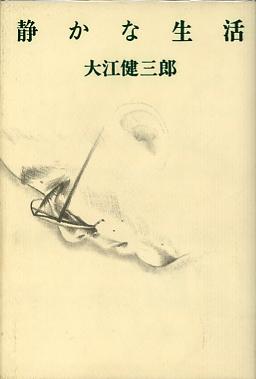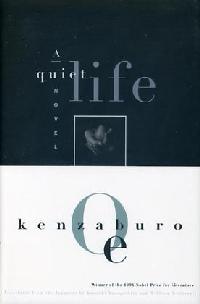A Quiet Life
By Oe Kenzaburo
Translated by Kunioki Yanagishita and William Wetherall
Beryl Bainbridge Numerous works of fiction and non-fiction are titled just "A Quiet Life" or include this phrase in their title. Sometimes it means just that -- a quiet life. More often it alludes to a life that is not so quiet. Bainbridge's novel, with numerous editions and reprintings, portrays a family of unhappy parents and troubled children who live emotionally miserable lives. When not used literally, ironically, or cynically, "a quiet life" may mean the sort of simple and peaceful life one someone manages to live in an otherwise complicated and noisy world. Oe_1990-10-25_Shizuka_na_seikatsu_1st_000a_yb_150.jpg Oe_1990-10-25_Shizuka_na_seikatsu_1st_000b_yb_150.jpg Oe_1990-10-25_Shizuka_na_seikatsu_1st_000c_yb_150.jpg大江健三郎 Ōe Kenzaburō This is the first edition of the novel, consisting of the following 6 short stories published in 5 different monthly magazines in 1990. The stories were written as "rensaku" (連作) or "connected works". As chapters in the novel, each story stands alone as a vignette within the larger connected story. Oe Kenzaburo Oe Kenzaburo The novelA Quiet Life is narrated by Ma-chan, a young woman who at the age of twenty finds herself in an unusual family situation. Her father is a famous and fascinating novelist; her older brother, though mentally handicapped, possesses and almost magical gift for musical composition. The lives of both father and son revolve around their work and each other, and her mother's life is devoted to the care of them both. She and her younger brother find themselves emotionally on the outside of this oddly constructed nuclear family. But when her father leaves Japan to accept a visiting professorship from a distinguished American university, Ma-chan finds herself suddenly the head of the household and the center of family relationships that she must begin to redefine. The storiesThough the novel appears to be a single work, its parts were originally published as six independent short stories, in five literary and popular monthly magazines.
The authorOe Kenzaburo was born in 1935 in the remote mountain village of Ose on Shikoku, the smallest of Japan's four main islands. He began publishing short stories while studying French literature at Tokyo University. In 1958, when 23 years old, he won the Akutagawa Prize for "Prize Stock" [Shiiku]. He has received many other literary honors, including the Prix Europalia in 1989 and the Nobel Prize for Literature in 1994. Oe's many translated works include: A Personal Matter; Teach Us to Outgrow Our Madness; The Silent Cry; Hiroshima Notes; Nip the Buds, Shoot the Kids; and Seventeen / J. The translatorsKunioki Yanagishita is a full-time instructor at the International Education center in Tokyo, where he is a senior (though slightly younger) colleague of the cotranslator. Over the years, he has translated a number of speeches and lectures for Oe, some of which appear in Kenzaburo Oe, Japan, the Ambiguous and Myself (The Nobel Prize Speech and Other Lectures) [Tokyo: Kodansha International, 1995, 128pp, $15.00]. William Wetherall has translated some of Oe's early short stories, including Unexpected muteness [Japan Quarterly, Vol. 36 No. 1, January-March 1989, pages 35-44]. He has also published an essay on Oe called Buffer Zones [Ibid., pages 32-34]. |

